MITS5003 Wireless Networks: WSN Case Study - Livestock Monitoring
VerifiedAdded on 2023/06/04
|6
|1141
|236
Case Study
AI Summary
This document presents a solution to a case study concerning the implementation of a Wireless Sensor Network (WSN) for livestock monitoring on a farm. The solution addresses various aspects of the WSN, including frequency band selection (2.45GHz), channel capacity calculations for communicat...
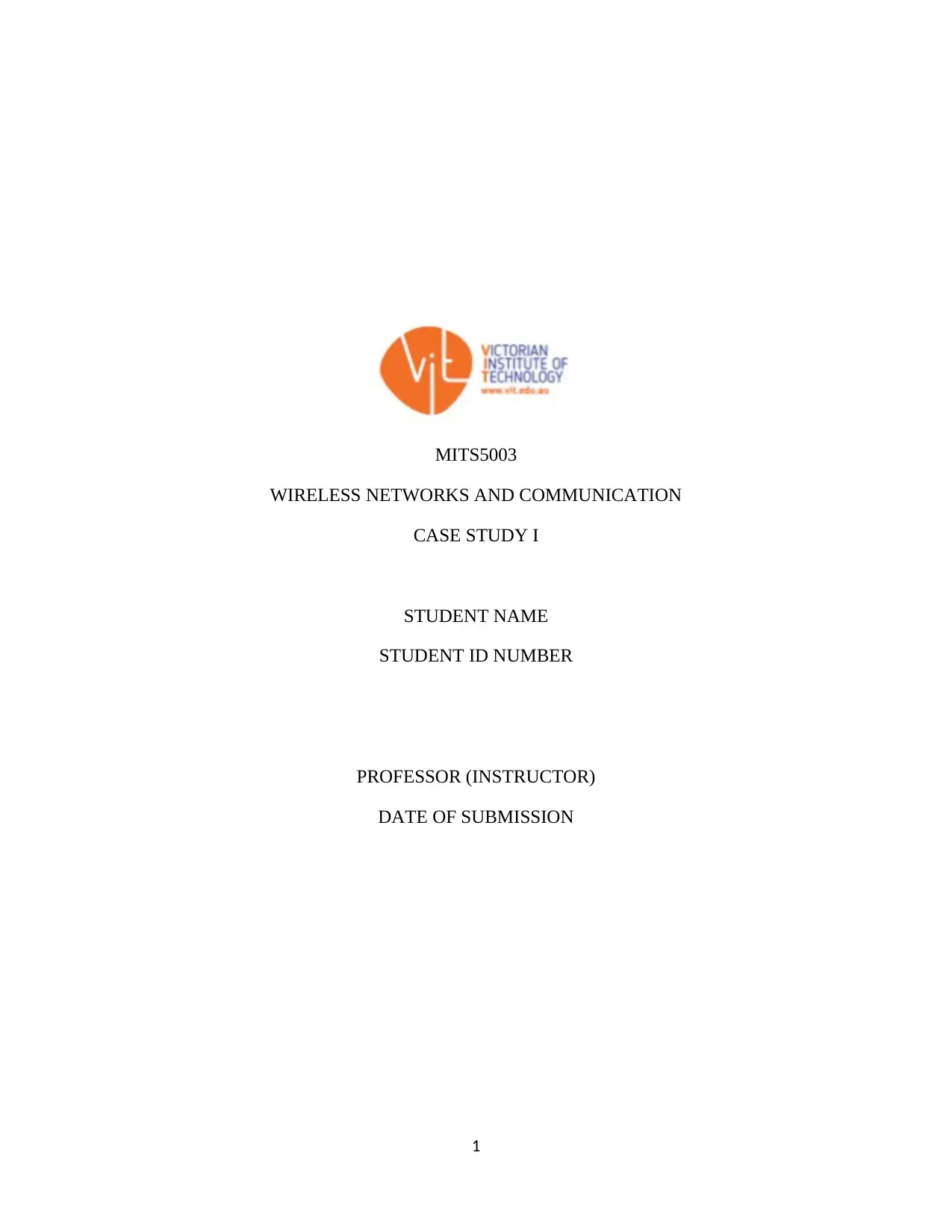
MITS5003
WIRELESS NETWORKS AND COMMUNICATION
CASE STUDY I
STUDENT NAME
STUDENT ID NUMBER
PROFESSOR (INSTRUCTOR)
DATE OF SUBMISSION
1
WIRELESS NETWORKS AND COMMUNICATION
CASE STUDY I
STUDENT NAME
STUDENT ID NUMBER
PROFESSOR (INSTRUCTOR)
DATE OF SUBMISSION
1
Paraphrase This Document
Need a fresh take? Get an instant paraphrase of this document with our AI Paraphraser
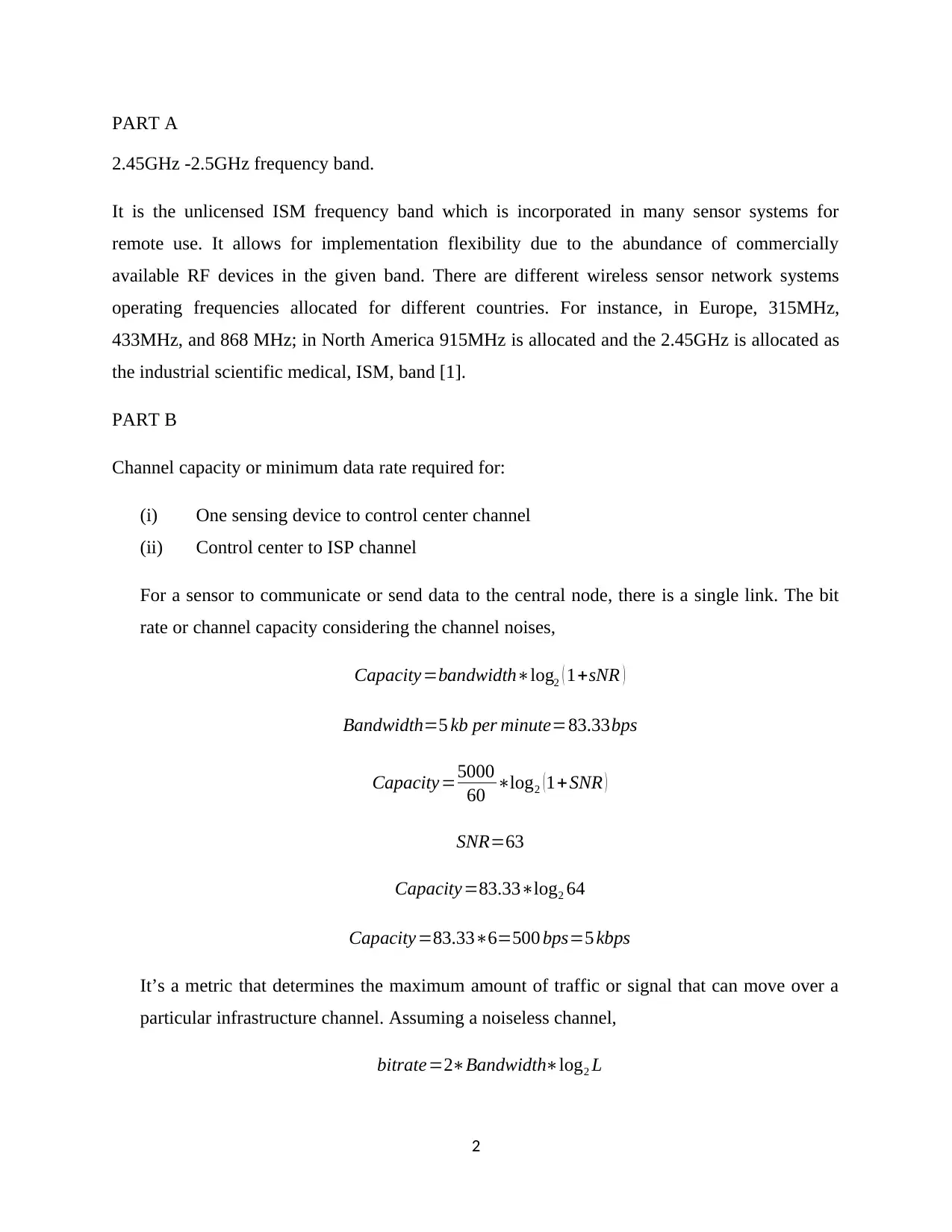
PART A
2.45GHz -2.5GHz frequency band.
It is the unlicensed ISM frequency band which is incorporated in many sensor systems for
remote use. It allows for implementation flexibility due to the abundance of commercially
available RF devices in the given band. There are different wireless sensor network systems
operating frequencies allocated for different countries. For instance, in Europe, 315MHz,
433MHz, and 868 MHz; in North America 915MHz is allocated and the 2.45GHz is allocated as
the industrial scientific medical, ISM, band [1].
PART B
Channel capacity or minimum data rate required for:
(i) One sensing device to control center channel
(ii) Control center to ISP channel
For a sensor to communicate or send data to the central node, there is a single link. The bit
rate or channel capacity considering the channel noises,
Capacity=bandwidth∗log2 ( 1+sNR )
Bandwidth=5 kb per minute=83.33bps
Capacity=5000
60 ∗log2 ( 1+SNR )
SNR=63
Capacity=83.33∗log2 64
Capacity=83.33∗6=500 bps=5 kbps
It’s a metric that determines the maximum amount of traffic or signal that can move over a
particular infrastructure channel. Assuming a noiseless channel,
bitrate=2∗Bandwidth∗log2 L
2
2.45GHz -2.5GHz frequency band.
It is the unlicensed ISM frequency band which is incorporated in many sensor systems for
remote use. It allows for implementation flexibility due to the abundance of commercially
available RF devices in the given band. There are different wireless sensor network systems
operating frequencies allocated for different countries. For instance, in Europe, 315MHz,
433MHz, and 868 MHz; in North America 915MHz is allocated and the 2.45GHz is allocated as
the industrial scientific medical, ISM, band [1].
PART B
Channel capacity or minimum data rate required for:
(i) One sensing device to control center channel
(ii) Control center to ISP channel
For a sensor to communicate or send data to the central node, there is a single link. The bit
rate or channel capacity considering the channel noises,
Capacity=bandwidth∗log2 ( 1+sNR )
Bandwidth=5 kb per minute=83.33bps
Capacity=5000
60 ∗log2 ( 1+SNR )
SNR=63
Capacity=83.33∗log2 64
Capacity=83.33∗6=500 bps=5 kbps
It’s a metric that determines the maximum amount of traffic or signal that can move over a
particular infrastructure channel. Assuming a noiseless channel,
bitrate=2∗Bandwidth∗log2 L
2
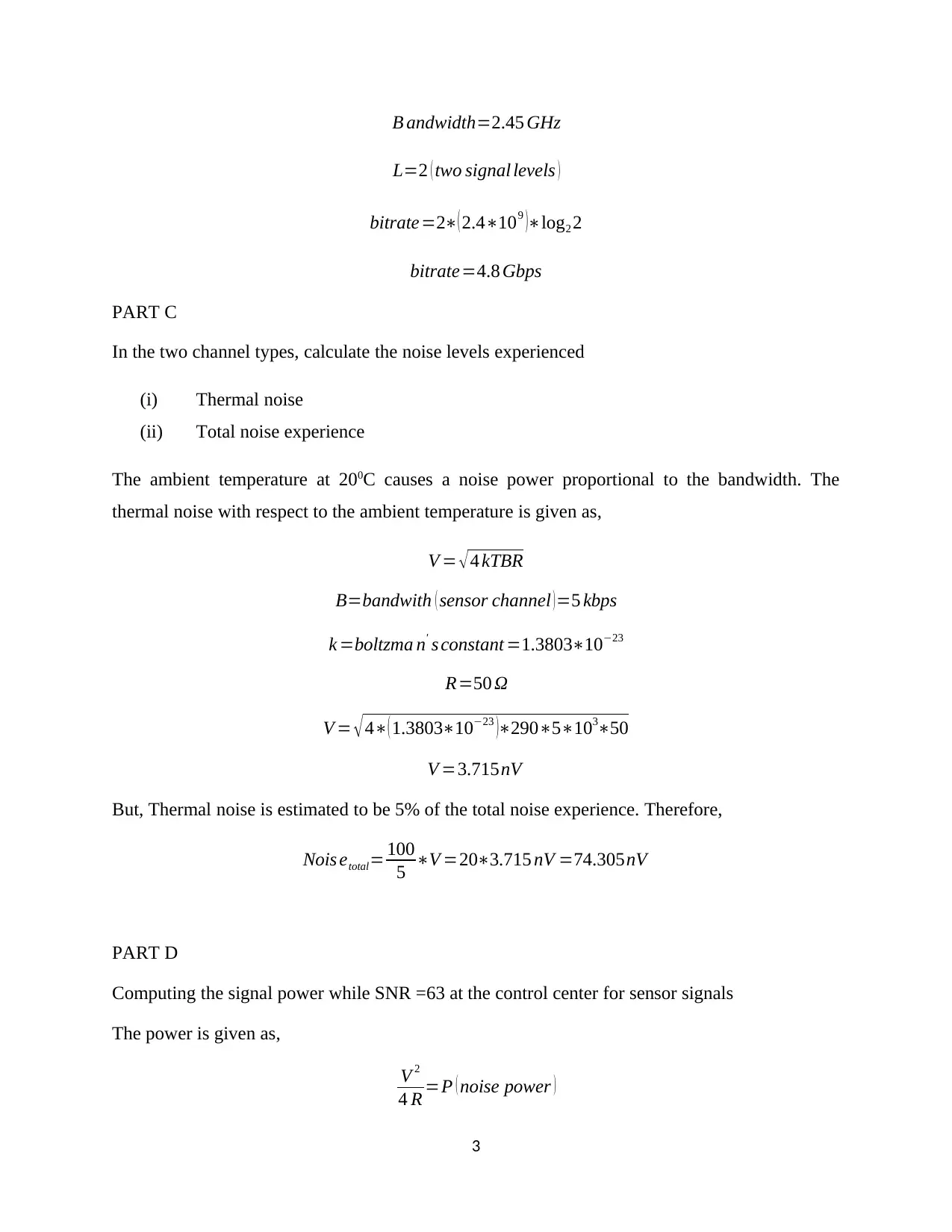
B andwidth=2.45 GHz
L=2 ( two signal levels )
bitrate=2∗( 2.4∗109 )∗log2 2
bitrate=4.8 Gbps
PART C
In the two channel types, calculate the noise levels experienced
(i) Thermal noise
(ii) Total noise experience
The ambient temperature at 200C causes a noise power proportional to the bandwidth. The
thermal noise with respect to the ambient temperature is given as,
V = √4 kTBR
B=bandwith ( sensor channel ) =5 kbps
k =boltzma n' s constant =1.3803∗10−23
R=50 Ω
V = √4∗( 1.3803∗10−23 )∗290∗5∗103∗50
V =3.715nV
But, Thermal noise is estimated to be 5% of the total noise experience. Therefore,
Nois etotal= 100
5 ∗V =20∗3.715 nV =74.305nV
PART D
Computing the signal power while SNR =63 at the control center for sensor signals
The power is given as,
V 2
4 R =P ( noise power )
3
L=2 ( two signal levels )
bitrate=2∗( 2.4∗109 )∗log2 2
bitrate=4.8 Gbps
PART C
In the two channel types, calculate the noise levels experienced
(i) Thermal noise
(ii) Total noise experience
The ambient temperature at 200C causes a noise power proportional to the bandwidth. The
thermal noise with respect to the ambient temperature is given as,
V = √4 kTBR
B=bandwith ( sensor channel ) =5 kbps
k =boltzma n' s constant =1.3803∗10−23
R=50 Ω
V = √4∗( 1.3803∗10−23 )∗290∗5∗103∗50
V =3.715nV
But, Thermal noise is estimated to be 5% of the total noise experience. Therefore,
Nois etotal= 100
5 ∗V =20∗3.715 nV =74.305nV
PART D
Computing the signal power while SNR =63 at the control center for sensor signals
The power is given as,
V 2
4 R =P ( noise power )
3
You're viewing a preview
Unlock full access by subscribing today!
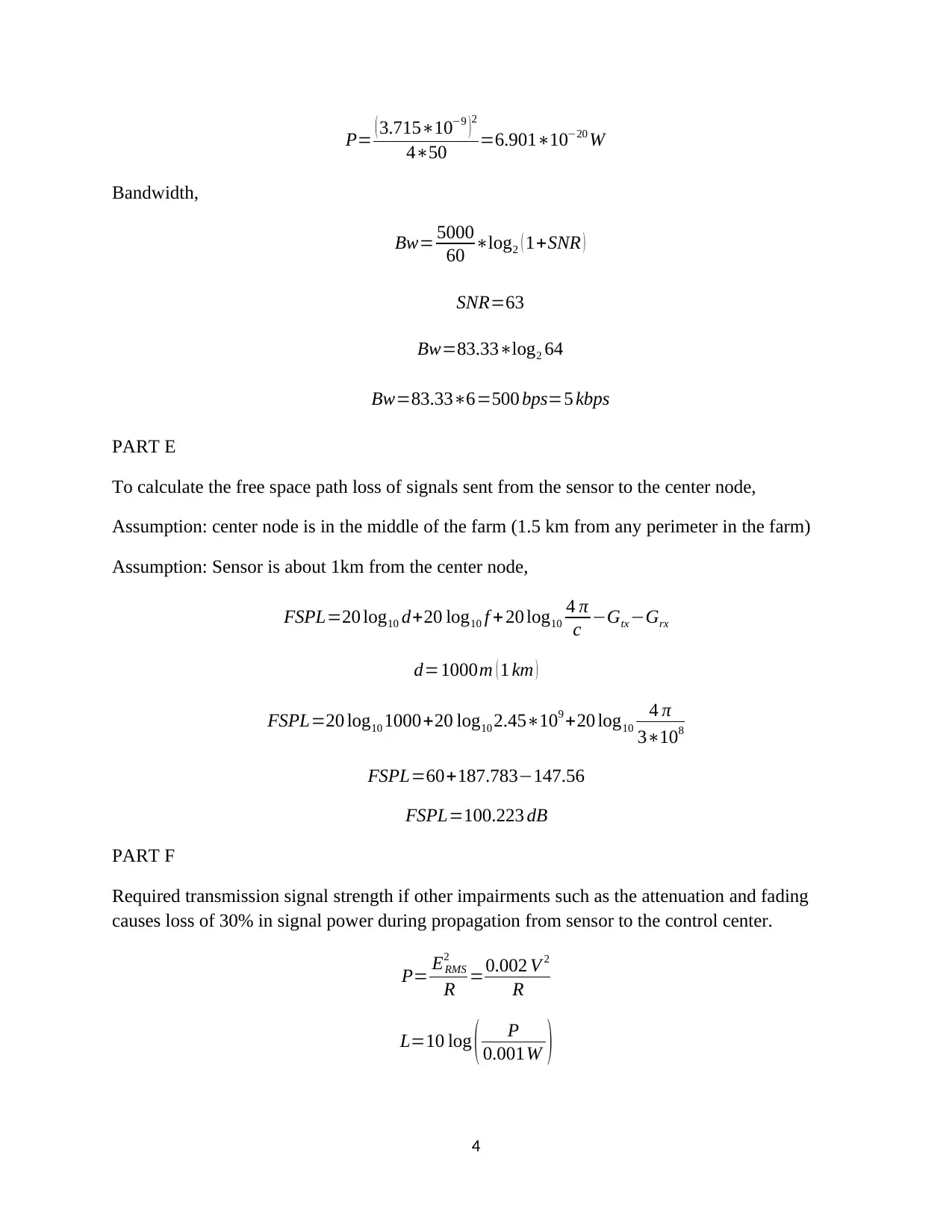
P= ( 3.715∗10−9 ) 2
4∗50 =6.901∗10−20 W
Bandwidth,
Bw= 5000
60 ∗log2 ( 1+SNR )
SNR=63
Bw=83.33∗log2 64
Bw=83.33∗6=500 bps=5 kbps
PART E
To calculate the free space path loss of signals sent from the sensor to the center node,
Assumption: center node is in the middle of the farm (1.5 km from any perimeter in the farm)
Assumption: Sensor is about 1km from the center node,
FSPL=20 log10 d+20 log10 f + 20 log10
4 π
c −Gtx −Grx
d=1000m ( 1 km )
FSPL=20 log10 1000+20 log10 2.45∗109 +20 log10
4 π
3∗108
FSPL=60+187.783−147.56
FSPL=100.223 dB
PART F
Required transmission signal strength if other impairments such as the attenuation and fading
causes loss of 30% in signal power during propagation from sensor to the control center.
P= ERMS
2
R =0.002 V 2
R
L=10 log ( P
0.001W )
4
4∗50 =6.901∗10−20 W
Bandwidth,
Bw= 5000
60 ∗log2 ( 1+SNR )
SNR=63
Bw=83.33∗log2 64
Bw=83.33∗6=500 bps=5 kbps
PART E
To calculate the free space path loss of signals sent from the sensor to the center node,
Assumption: center node is in the middle of the farm (1.5 km from any perimeter in the farm)
Assumption: Sensor is about 1km from the center node,
FSPL=20 log10 d+20 log10 f + 20 log10
4 π
c −Gtx −Grx
d=1000m ( 1 km )
FSPL=20 log10 1000+20 log10 2.45∗109 +20 log10
4 π
3∗108
FSPL=60+187.783−147.56
FSPL=100.223 dB
PART F
Required transmission signal strength if other impairments such as the attenuation and fading
causes loss of 30% in signal power during propagation from sensor to the control center.
P= ERMS
2
R =0.002 V 2
R
L=10 log ( P
0.001W )
4
Paraphrase This Document
Need a fresh take? Get an instant paraphrase of this document with our AI Paraphraser
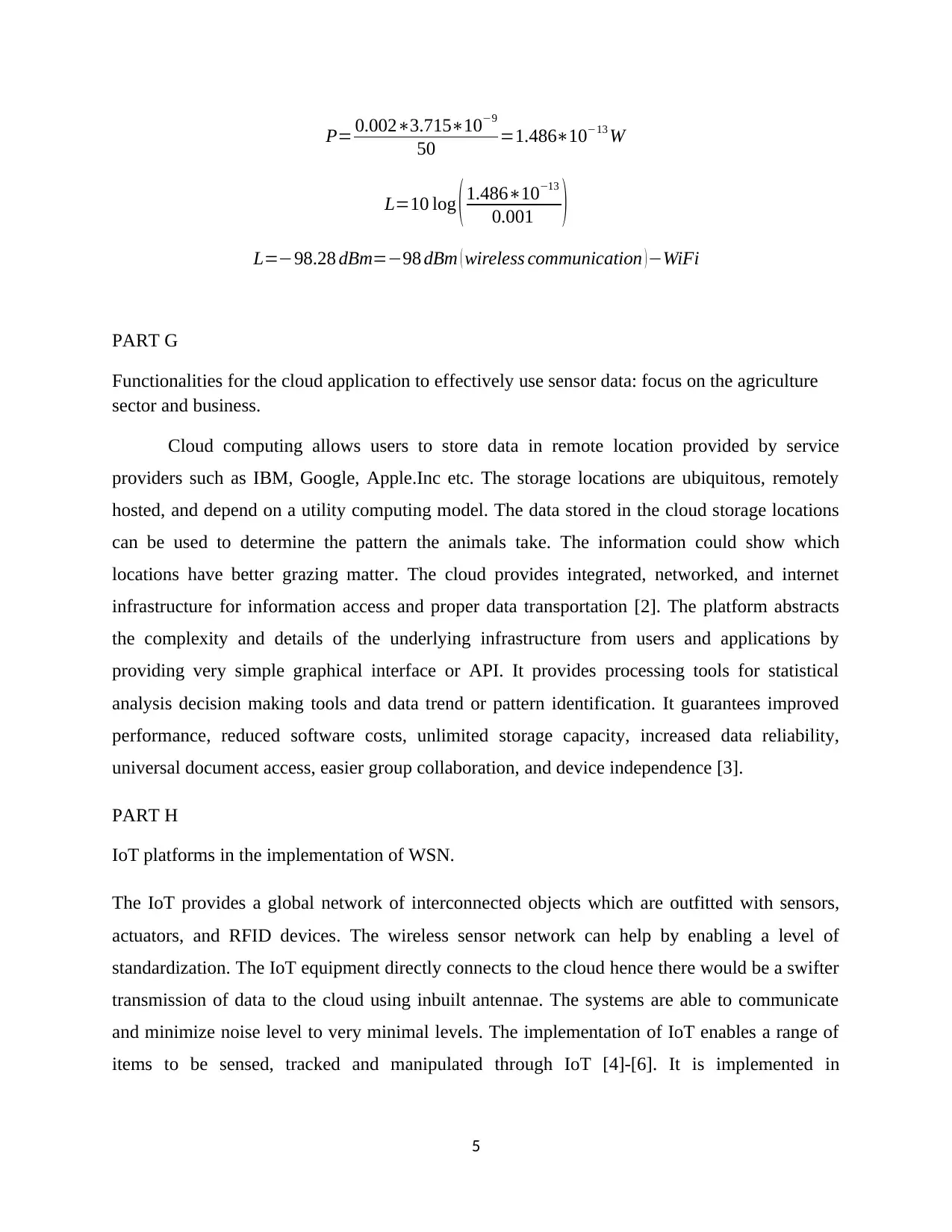
P= 0.002∗3.715∗10−9
50 =1.486∗10−13 W
L=10 log (1.486∗10−13
0.001 )
L=−98.28 dBm=−98 dBm ( wireless communication )−WiFi
PART G
Functionalities for the cloud application to effectively use sensor data: focus on the agriculture
sector and business.
Cloud computing allows users to store data in remote location provided by service
providers such as IBM, Google, Apple.Inc etc. The storage locations are ubiquitous, remotely
hosted, and depend on a utility computing model. The data stored in the cloud storage locations
can be used to determine the pattern the animals take. The information could show which
locations have better grazing matter. The cloud provides integrated, networked, and internet
infrastructure for information access and proper data transportation [2]. The platform abstracts
the complexity and details of the underlying infrastructure from users and applications by
providing very simple graphical interface or API. It provides processing tools for statistical
analysis decision making tools and data trend or pattern identification. It guarantees improved
performance, reduced software costs, unlimited storage capacity, increased data reliability,
universal document access, easier group collaboration, and device independence [3].
PART H
IoT platforms in the implementation of WSN.
The IoT provides a global network of interconnected objects which are outfitted with sensors,
actuators, and RFID devices. The wireless sensor network can help by enabling a level of
standardization. The IoT equipment directly connects to the cloud hence there would be a swifter
transmission of data to the cloud using inbuilt antennae. The systems are able to communicate
and minimize noise level to very minimal levels. The implementation of IoT enables a range of
items to be sensed, tracked and manipulated through IoT [4]-[6]. It is implemented in
5
50 =1.486∗10−13 W
L=10 log (1.486∗10−13
0.001 )
L=−98.28 dBm=−98 dBm ( wireless communication )−WiFi
PART G
Functionalities for the cloud application to effectively use sensor data: focus on the agriculture
sector and business.
Cloud computing allows users to store data in remote location provided by service
providers such as IBM, Google, Apple.Inc etc. The storage locations are ubiquitous, remotely
hosted, and depend on a utility computing model. The data stored in the cloud storage locations
can be used to determine the pattern the animals take. The information could show which
locations have better grazing matter. The cloud provides integrated, networked, and internet
infrastructure for information access and proper data transportation [2]. The platform abstracts
the complexity and details of the underlying infrastructure from users and applications by
providing very simple graphical interface or API. It provides processing tools for statistical
analysis decision making tools and data trend or pattern identification. It guarantees improved
performance, reduced software costs, unlimited storage capacity, increased data reliability,
universal document access, easier group collaboration, and device independence [3].
PART H
IoT platforms in the implementation of WSN.
The IoT provides a global network of interconnected objects which are outfitted with sensors,
actuators, and RFID devices. The wireless sensor network can help by enabling a level of
standardization. The IoT equipment directly connects to the cloud hence there would be a swifter
transmission of data to the cloud using inbuilt antennae. The systems are able to communicate
and minimize noise level to very minimal levels. The implementation of IoT enables a range of
items to be sensed, tracked and manipulated through IoT [4]-[6]. It is implemented in
5
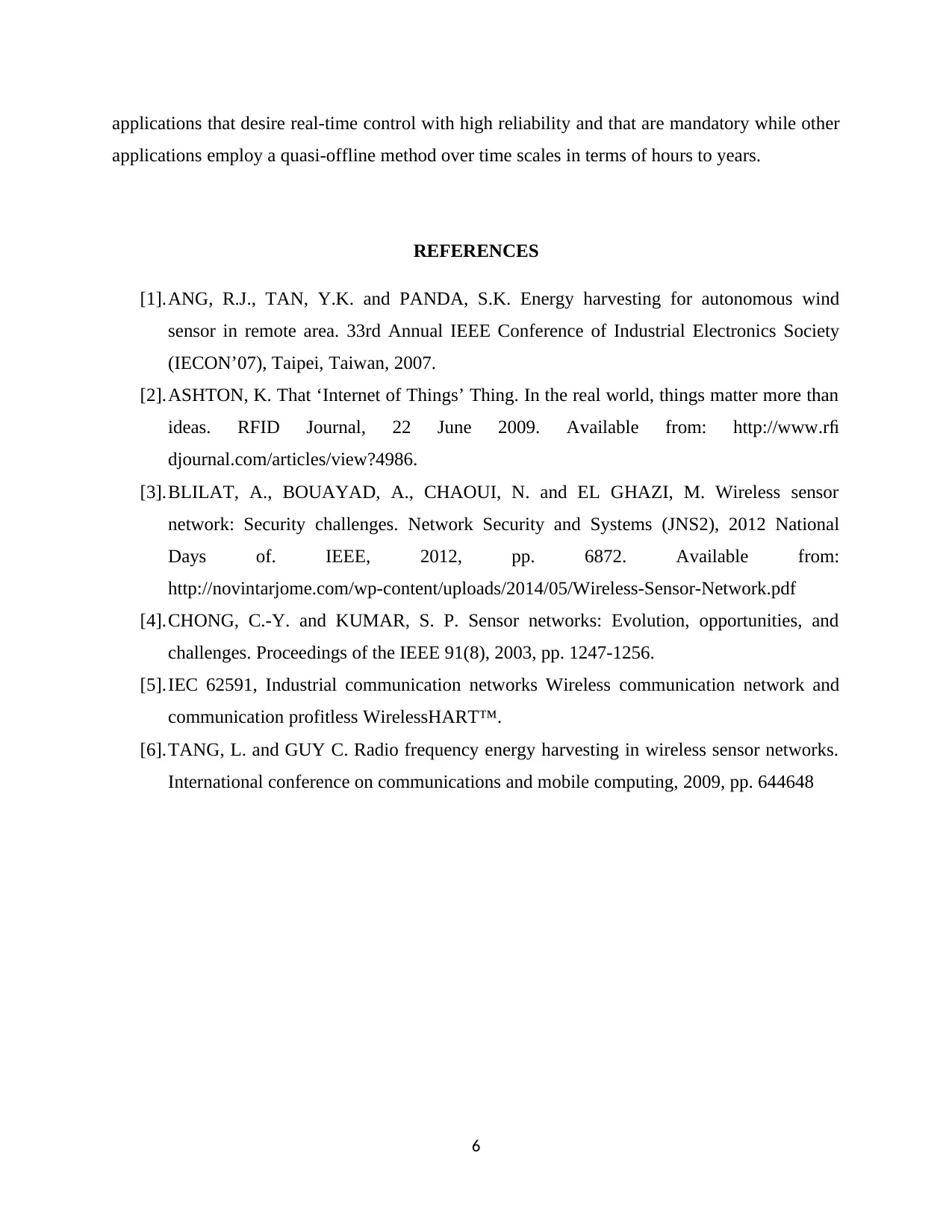
applications that desire real-time control with high reliability and that are mandatory while other
applications employ a quasi-offline method over time scales in terms of hours to years.
REFERENCES
[1].ANG, R.J., TAN, Y.K. and PANDA, S.K. Energy harvesting for autonomous wind
sensor in remote area. 33rd Annual IEEE Conference of Industrial Electronics Society
(IECON’07), Taipei, Taiwan, 2007.
[2].ASHTON, K. That ‘Internet of Things’ Thing. In the real world, things matter more than
ideas. RFID Journal, 22 June 2009. Available from: http://www.rfi
djournal.com/articles/view?4986.
[3].BLILAT, A., BOUAYAD, A., CHAOUI, N. and EL GHAZI, M. Wireless sensor
network: Security challenges. Network Security and Systems (JNS2), 2012 National
Days of. IEEE, 2012, pp. 6872. Available from:
http://novintarjome.com/wp-content/uploads/2014/05/Wireless-Sensor-Network.pdf
[4].CHONG, C.-Y. and KUMAR, S. P. Sensor networks: Evolution, opportunities, and
challenges. Proceedings of the IEEE 91(8), 2003, pp. 1247-1256.
[5].IEC 62591, Industrial communication networks Wireless communication network and
communication profitless WirelessHART™.
[6].TANG, L. and GUY C. Radio frequency energy harvesting in wireless sensor networks.
International conference on communications and mobile computing, 2009, pp. 644648
6
applications employ a quasi-offline method over time scales in terms of hours to years.
REFERENCES
[1].ANG, R.J., TAN, Y.K. and PANDA, S.K. Energy harvesting for autonomous wind
sensor in remote area. 33rd Annual IEEE Conference of Industrial Electronics Society
(IECON’07), Taipei, Taiwan, 2007.
[2].ASHTON, K. That ‘Internet of Things’ Thing. In the real world, things matter more than
ideas. RFID Journal, 22 June 2009. Available from: http://www.rfi
djournal.com/articles/view?4986.
[3].BLILAT, A., BOUAYAD, A., CHAOUI, N. and EL GHAZI, M. Wireless sensor
network: Security challenges. Network Security and Systems (JNS2), 2012 National
Days of. IEEE, 2012, pp. 6872. Available from:
http://novintarjome.com/wp-content/uploads/2014/05/Wireless-Sensor-Network.pdf
[4].CHONG, C.-Y. and KUMAR, S. P. Sensor networks: Evolution, opportunities, and
challenges. Proceedings of the IEEE 91(8), 2003, pp. 1247-1256.
[5].IEC 62591, Industrial communication networks Wireless communication network and
communication profitless WirelessHART™.
[6].TANG, L. and GUY C. Radio frequency energy harvesting in wireless sensor networks.
International conference on communications and mobile computing, 2009, pp. 644648
6
You're viewing a preview
Unlock full access by subscribing today!
1 out of 6
Related Documents
Your All-in-One AI-Powered Toolkit for Academic Success.
+13062052269
info@desklib.com
Available 24*7 on WhatsApp / Email
![[object Object]](/_next/static/media/star-bottom.7253800d.svg)
Unlock your academic potential
© 2024 | Zucol Services PVT LTD | All rights reserved.


